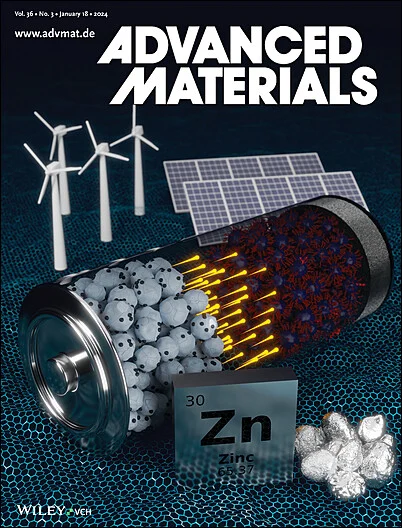通过选择性排斥吸附和分子间离子传导层增强高能密度无阳极锂金属电池的Li+动力学
IF 26.8
1区 材料科学
Q1 CHEMISTRY, MULTIDISCIPLINARY
引用次数: 0
摘要
无阳极锂金属电池提供高能量密度,但由于阳极Li+溶解缓慢,寿命有限。阳极上的传统人工层通过极性基团吸引Li+,但无意中在这些极性层附近积聚溶剂分子,阻碍了脱溶,形成了具有低离子电导率的富有机固体电解质界面(SEI)。本文提出了一种选择性排斥吸附策略,使用由聚苯乙烯磺酸(PSS)和蒙脱土(MMT)组成的层(质层,35 nm)来实现。在电喷雾制造过程中,PSS自组装,非极性苯环和C - H主链向外,而- SO3 -基团埋在下面。非极性组分可以排斥极性溶剂分子,带负电荷的MMT会吸附Li+,抑制溶剂积累,促进溶剂脱溶。同时,被MMT吸引的阴离子将形成具有优异离子导电性的富无机SEI。此外,PSS - MMT界面形成了一个快速的Li+运输途径,减少了迁移障碍。因此,无阳极MS - Cu||LFP电池可以运行超过350个周期,与Cu||LFP电池相比,增加了约200%。此外,2 Ah无阳极MS - Cu||LFP (340 Wh kg - 1)和MS - Cu||NCM811袋电池(490 Wh kg - 1)在100次和50次循环后保持80%的容量。这项工作提出了一种有效的策略来提高高性能电池的Li+动力学。本文章由计算机程序翻译,如有差异,请以英文原文为准。
Enhancing Li+ Kinetics Via Selective Repulsion‐Adsorption and Intermolecular Ion‐Conduction Layers for High‐Energy‐Density Anode‐Free Lithium‐Metal Batteries
Anode‐free lithium‐metal batteries, offer high energy density, but suffer from limited lifespan due to sluggish Li+ desolvation at the anode. Conventional artificial layers on the anode attract Li+ by polar groups, yet inadvertently accumulate solvent molecules near these polar layers, impede desolvation, and form an organic‐rich solid electrolyte interphase (SEI) with low ionic conductivity. Herein, a selective repulsion‐adsorption strategy is proposed, achieved using a layer (MS layer, 35 nm) comprising polystyrene sulfonic acid (PSS) and montmorillonite (MMT). During electrospray fabrication, the PSS self‐assemble, with non‐polar benzene rings and C‐H main chains facing outward, while the ‐SO3 − groups are buried underneath. The non‐polar components can repel polar solvent molecules, and negatively charged MMT will absorb Li+ , suppressing solvent accumulation and facilitating desolvation. Meanwhile, the anions attracted by MMT will form an inorganic‐rich SEI with superior ionic conductivity. Furthermore, the PSS‐MMT interface forms a rapid Li+ transport pathway with reduced migration barriers. Consequently, anode‐free MS‐Cu||LFP cells operate over 350 cycles, increasing ≈200% compared with Cu||LFP cells. Additionally, 2 Ah anode‐free MS‐Cu||LFP (340 Wh kg−1 ) and MS‐Cu||NCM811 pouch cells (490 Wh kg−1 ) maintain 80% capacity after 100 and 50 cycles. This work presents an efficient strategy to enhance Li+ kinetics for high‐performance batteries.
求助全文
通过发布文献求助,成功后即可免费获取论文全文。
去求助
来源期刊

Advanced Materials
工程技术-材料科学:综合
CiteScore
43.00
自引率
4.10%
发文量
2182
审稿时长
2 months
期刊介绍:
Advanced Materials, one of the world's most prestigious journals and the foundation of the Advanced portfolio, is the home of choice for best-in-class materials science for more than 30 years. Following this fast-growing and interdisciplinary field, we are considering and publishing the most important discoveries on any and all materials from materials scientists, chemists, physicists, engineers as well as health and life scientists and bringing you the latest results and trends in modern materials-related research every week.
 求助内容:
求助内容: 应助结果提醒方式:
应助结果提醒方式:


